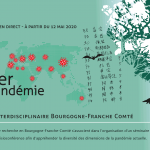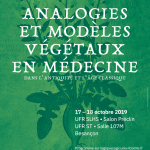Le laboratoire Logiques de l’Agir a le plaisir de vous convier à son séminaire le mercredi 16 octobre 2019 à 18h00 à l’UFR SLHS de l’Université de Franche-Comté en salle E14 (Grand Salon), entrée par le 18 rue Chifflet, 25000 Besançon.
Nous recevrons Laura Rival (université d’Oxford) qui prononcera une conférence intitulée:Why and How Do Plants Grow?
The intention behind this experimental essay is to consolidate anthropology’s epistemological standpoint in its varied engagements with post-human studies of ‘other-than-human worlds.’ I ask two anthropological questions: (i) Do ‘other-than-humans’ really enjoy a social life? (ii) Would it be correct to assert that humans are naturally social while other living organisms, such as trees (and plants more generally) are so only metaphorically? I put these two questions to the test of a new brand of geography that has gone viral at Oxford, where cultural geography (a branch of human geography that was always at odds with itself in the British Isles) has morphed into ‘more-than-human geography,’ defined by its proponents as a new ‘mode of geographical theorization of nature-society relations’ that takes the world to be an ‘emergent outcome of a specific assemblage in which heterogeneous actors perform together.’ They define ‘world’ as anything that is produced through the mixing and hybridization of nature and society.
I start by revisiting a volume I edited years ago, The social life of trees. Anthropological perspectives on tree symbolism, in light of a cultural geography book published a few years later (by the same publishing house), Tree cultures. The place of trees and trees in their place. Whereas the book I edited purported to document cross-culturally the status of trees as ‘crystallisations of the life process,’ the book written by British geographers Jones and Cloke focused on trees in contemporary English urban settings. Their intent was to articulate the thesis (also defended by Tim Ingold) that ‘the social world is not bounded by the limits of humanity, with an asocial nature beyond.’ The social life of trees aimed at critically engaging Mary Douglas’ approach to natural symbols: on the one hand her assertion that symbols can only signify social relations, and, on the other hand, her ultimate rendering of natural symbols as pure social conventions expressing class consciousness in the form of polite, progressive order. Through a focus on issues of non-representational agency and affect, Tree cultures, by contrast, aimed at demonstrating that ‘the social world embraces relations with, and among, beings of all kinds.’
Having set the context in which epistemological debates about social constructionism and new materialisms have flourished within and across anthropology and geography over the last three decades, I bring the discussion to the crux of the matter: growth. Growth, a concept with which plant life is most often associated (at least in popular imagination), initially brought me to pay attention to trees among the Huaorani in the Ecuadorian Amazon. I examine the relationship between growth and plant life in the work of another colleague at Oxford, a plant biologist who has spent his career researching the genetics of plant growth. I am particularly interested in the moment when he steps out of the laboratory and starts observing, in a church yard and for a whole calendar year ,the natural life cycle of an individual plant, whose species he has spent years studying at the level of its genetics. His decision to step out of the lab was in part prompted by a question from his six-years old daughter, which he could not readily answer: Why do plants grow, Dad?
I am still unsure as to where these reflections are going to lead, except that they will inevitably involve going back to the anthropology of time, as well as to current anthropological debates about transcendence.
Laura Rival est anthropologue, Professeure à l’Université d’Oxford. Sa recherche a tout particulièrement trouvé son terrain en Amazonie, auprès des Huaorani en Equateur et des Makushi en Guyane. Elle a contribué à renouvelée notre compréhension de la façon dont les sociétés humaines vivent et pensent avec leur environnement. Elle a écrit ou dirigé de nombreux volumes, dont The Social Life of Trees. Anthropological Perspectives on Tree Symbolism (1998) ; Governing the Provision of Ecosystem Services (Co-Edited with Roldan Muradian, 2012) ; Huaorani Transformations in 21st Century Ecuador. Treks to the Future of Time (2018). On mentionnera aussi l’article séminal de 1993 : « The Growth of Family Trees: Huaorani Conceptualization of Nature and Society » (Man, Vol. 28, No. 4, pp. 635-652)






